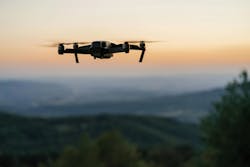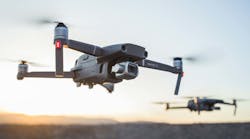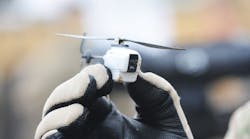Why drones are the bad actors’ new toy
Recent events all over the country have once again shone a light on how drones have emerged as the tool of choice for clueless or bad actors targeting critical infrastructure (CI), posing unprecedented risks to national security and public safety.
Reports in December of unknown drone activity in New Jersey, as well as pausing air traffic in two states – at an airport (New York) and an Air Force Base (Ohio) – began a much-needed national and policy conversation on how best to tackle both reckless and potentially nefarious drone activities at our Nation’s most valuable infrastructure sites.
It seems quaint now, but once viewed as recreational gadgets, unmanned aerial systems (UAS) have morphed into sophisticated platforms for espionage, sabotage, and intentional and unintentional operational disruption, as highlighted by these recent situations. As these threats escalate, the urgency for robust counter-UAS (C-UAS) solutions becomes impossible to ignore.
What happened in New Jersey, New York, Ohio and beyond is just the latest in what has become an increasingly concerning list of incidents that highlight the growing severity of drone-related threats. Internationally, Sweden’s Stockholm Arlanda Airport recently faced a similar (and significant) security breach when UAS sightings forced the suspension of air traffic, disrupting operations and endangering travelers. In one particularly chilling example, a man in Nashville attempted to weaponize a drone with explosives to target an energy facility. Such incidents underscore the potential for catastrophic consequences when CI sites are unprepared.
Why are CI sites particularly vulnerable to potential airspace threats? These facilities include energy facilities, airports, water treatment plants, and transportation hubs and are high-value targets for adversaries seeking to maximize impact. These locations are essential for maintaining societal function, yet airspace awareness technologies are not typically deployed at CI sites, making them easy targets for airborne threats. The footprint scale from our country’s CI is also worth highlighting, with over 2,400,000 miles of energy pipelines, 14,000+ water and treatment plants, more than 5,000 airports with paved runways, and many more sites dotted throughout the land.
While the motivations of attackers of CI locations vary, from state-sponsored espionage and terrorism to criminal enterprises aiming to steal intellectual property or seeking to cause widespread chaos, the low cost, accessibility, and ease of modification of drones make them particularly attractive tools for such nefarious activities.
A New Frontier in Security: C-UAS Technology
Traditional security systems, designed to counter ground-level threats, are ill-equipped to handle the situational awareness challenges posed by drones. Such systems have tended to consist of thermal sensors, cameras, a human guard and potentially a radio frequency (RF) sensor.
Addressing the evolving threat from drones requires a layered approach infused with innovative solutions that combine advanced detection, tracking, and mitigation technologies.
Traditional security systems, designed to counter ground-level threats, are ill-equipped to handle the situational awareness challenges posed by drones.
For example, radar systems provide high-precision drone detection, enabling real-time tracking even in challenging weather and lighting conditions, even in complex environments. This makes this sensor an essential component of a layered approach. Meanwhile, radio frequency (RF) detection technologies can analyze the radio signatures and modulations specific to drone signals, identify certain make/models, and locate the signal’s transmission origin, including the drone itself or the pilot’s location. This mix also includes optical sensors, such as pan-tilt-zoom (PTZ) cameras and thermal imaging systems. These complement radar and RF detection technology by providing visual confirmation and detailed analysis of detected drones.
The integration of such a comprehensive C-UAS technology stack can dramatically improve the resilience of CI sites. Advanced radars, RF detection systems, and PTZs work together to create an impenetrable defense layer. Organizations can protect their assets and the public they serve by adopting these solutions, preventing potentially devastating consequences.
A Moving Toward Actionable Solutions
The need for proactive investment in C-UAS technologies has never been more critical as incidents continue to grow. Government and private sector stakeholders must collaborate to establish standards, fund research, and ensure CI sites are equipped to combat drone-related threats. Without decisive action, the risks will multiply, jeopardizing national security, economic stability, and public safety.
This is especially important given the events in December, which spurred lawmakers to discuss at length the current blind spots our CI faces from drones while also laying out a potential legislative path forward. Safeguarding the Homeland from the Threats Posed by the Unmanned Aircraft Systems Act of 2023 (S.1631) was tabled as one approach. It seeks to empower CI and law enforcement to use various drone detection technologies to protect our critical infrastructure.
In tandem with this political push to adapt to a new security environment, crucially, it also appears that the American public is keenly aware of the importance of CI, with 90% believing it plays a massive role in maintaining daily life activities, according to research from MITRE-Harris in 2024. Not only this, the data also found that eight in ten (88%) think protecting CI is “a matter of national security,” and 78% feel that the federal government bears full or partial responsibility for fortifying America’s CI sites.
For now, though, we must accept that we’re in a new environment that requires new approaches. The battle against bad actors is simply no longer confined to the ground. With drones taking flight as a tool of destruction, all stakeholders, from policymakers to the security community, must rise to the challenge and safeguard the critical infrastructure that powers and protects our modern way of life.
About the Author

Yaniv Mendelson
Director of cUAS Partnerships at Echodyne
Yaniv Mendelson is the Director of Business Development at Echodyne, a leader in cutting-edge radar technologies. With over 20 years of experience in business development, sales, system integration, and project management, Yaniv has consistently driven the adoption of advanced radar and sensing solutions across dynamic, high-stakes industries. Before joining Echodyne, Yaniv held senior leadership roles at Xsight Systems, a global pioneer in Foreign Object Debris (FOD) detection radar, and Gilat Satellite Networks, where he specialized in advanced antenna systems. Yaniv holds a Master of Science in Electrical and Electronics Engineering with a specialty in radar technologies and a Bachelor of Science from Tel Aviv University. His blend of technical expertise and strategic leadership continues to shape innovation and growth in the radar and sensing landscape.

Tom Adams
Director of Public Safety at DroneShield
Tom Adams retired from the FBI after 20 years of service in 2022. He spent most of his career as a Special Agent Bomb Technician supporting counter-terrorism efforts in the U.S. and worldwide. During the last three years of his career, he was a supervisory special agent in the FBI’s counter-UAS program. In that role, he helped shape the team’s policies, procedures, and training. He has planned and conducted numerous homeland security counter-UAS missions in complex urban environments and high-profile venues around the U.S., including Super Bowls, World Series, and Rose Bowls.
Since leaving the FBI, he built a Counter-UAS resource website. He served as the Co-Chair of the Operating Requirements Working Group for the FAA UAS Detection and Mitigation Aviation Rulemaking Committee, which published its final report earlier this year. Tom is now the Director of Public Safety for DroneShield, a provider of multi-mission counter-UXS solutions.


